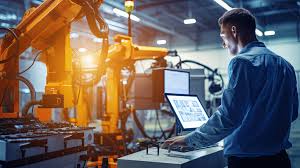AI-Driven Robotic Automation in an Automotive Components Plant in Pune, India
Company Name: (Confidential – referred to as “AutoMech Components”)
Industry: Automotive Components (Engine brackets, transmission casings, precision assemblies)
Size: 600+ employees
Annual Turnover: ₹500+ crore
Clients: Tata Motors, Mahindra, Bosch, Hyundai India
Location: Pune, Maharashtra
Facilities: 2 manufacturing plants, 1 assembly unit
AutoMech was a fast-growing Tier-1 supplier in India’s automotive manufacturing ecosystem. With tightening timelines, rising labor costs, and growing demand for defect free precision assemblies, the leadership decided to explore AI-powered automation and robotics.
The vision was to automate repetitive processes, reduce human errors, and use AI to optimize production line decisions in real time
Challenges Before Automation
Despite their success, AutoMech faced growing pressure in areas like:
- Labor Variability
○ Frequent absenteeism and dependency on manual labor caused delays.
○ Labor churn made it hard to maintain consistency. - Assembly Line Bottlenecks
○ Some workstations (especially torque-tightening, welding) were slower, creating downstream delays. - Manual Inspection & Rejection
○ Quality inspectors manually checked components with tools and gauges.
○ Subjectivity led to inconsistent results. - Lack of Predictive Maintenance
○ Unplanned downtime from equipment failures often led to missed SLAs. - High Internal Rejection Rate
○ Parts rejected post-machining or assembly resulted in significant waste (2.7%).
The company needed not just automation but intelligent automation, where AI could adapt, learn, and optimize.
Solution: AI-Driven Robotics + Computer Vision +Predictive Maintenance
Objectives
● Use AI for defect detection, torque monitoring, and visual inspection.
● Implement collaborative robots (cobots) for repetitive assembly tasks.
● Optimize production flow with real-time decision-making algorithms.
● Reduce rejection, improve uptime, and maintain traceability

Components of the AI & Automation Deployment
- Robotic Workstations (3 Key Areas Automated)
● Torque Wrenching: Cobots mounted with smart torque tools installed on 2 assembly lines.
● Welding Station: Automated TIG welding station with vision guidance system.
● Pick & Place Units: Parts are moved between CNC machines and conveyor belts using SCARA robots. - AI-Powered Vision Inspection System
● High-res industrial cameras are installed at inspection stations.
● AI model trained on 2.5 lakh images to detect defects like misalignment, scratches, and dimensional mismatches.
● Real-time accept and reject flag and feedback loop to the operator panel. - Predictive Maintenance Engine
● Sensors are installed on critical equipment (spindles, compressors).
● Time-series data fed into an ML algorithm to forecast failure based on vibration, temperature, and power draw.
● Maintenance alerts are triggered via the dashboard + SMS to the line manager. - Integrated Control Dashboard
● Real-time metrics on OEE, rejection, and line throughput.
● Color-coded alerts for equipment anomalies, productivity dips, and QA issues.
● Hosted on a secure internal cloud (private AWS instance).
Implementation Timeline
| Phase | Duration | Description |
| Phase 1: Design & Feasibility | 1.5 months | Identified key automation areas, built ROI model |
| Phase 2: Procurement & Setup | 2.5 months | Installed cobots, vision systems, and IIoT sensors |
| Phase 3: AI Training & Tuning | 1 month | Collected data, trained models (inspection + predictive) |
| Phase 4: Go-Live | 1 month | Full integration into production lines +training |
| Phase 5: Optimization | ongoing | AI model updates, dashboard enhancements, and scaling across the plant |
Results: 6 Months Post Implementation
| Metric | Before | After | Change |
| Internal Rejection Rate | 2.7% | 0.9% | ↓ 66.7% |
| Assembly Line Throughput | 170 units/hr | 215 units/hr | ↑ 26% |
| Quality Inspection Time/Part | 12 sec | 4 sec | ↓ 67% |
| Unplanned Downtime | 18 hrs/month | 5 hrs/month | ↓ 72% |
| First-Time Yield (FTY) | 91.3% | 97.6% | ↑ 6.3% |
| ROI Period | – | 11 months | Fully recovered investment |
Employee Transition & Training
Rather than replacing workers, the company reskilled many to work alongside the new systems:
● 18 workers were trained as robotic cell operators.
● 6 quality inspectors were promoted as AI inspection overseers to validate edge cases.
● Team leaders attended workshops on AI dashboard interpretation for decision making.
Union concerns were addressed early with transparency and commitment to upskilling, not downsizing
AI Training & Model Specifics
● Vision model trained on YOLOv7 architecture, retrained monthly with new edge cases.
● Predictive maintenance model used LSTM-based time series forecasting with 90 %+ accuracy for 3 key machine types.
● False positives on defect detection dropped from 9.4% (first month) to 1.8% (by month 5).
Strategic Benefits
- Client Confidence: AutoMech’s largest client, Tata Motors, gave a commendation and increased order share.
- Compliance Readiness: AI-based documentation helped during the ISO 9001 recertification audit.
- Scalability: Model is being scaled to the second plant by Q4.
- Cost Control: Reduction in part rejection saved ~₹1.8 Cr annually.
Lessons Learned
● Data is Everything: Quality of AI outcomes improved drastically with domain specific datasets.
● AI Is Iterative: Regular feedback loops were necessary to fine tune inspection and prediction.
● Start with Pilot Cells: 3 stations automated initially before scaling to 7+ areas.
● Human-AI Collaboration Works: When properly trained, workers enhanced AI decision accuracy
Next Steps
● Expand AI inspection to packaging and labeling QC.
● Integrate MES (Manufacturing Execution System) with ERP for deeper analytics.
● Add anomaly detection for welding patterns using AI thermal imagery.
● Cloud-based dashboard for remote plant monitoring by leadership
Conclusion
AutoMech Components’ AI and robotics integration is a textbook example of intelligent automation in the Indian automotive supply chain. Beyond efficiency and
cost gains, the company created a modern, data-driven culture on the factory floor. By respecting human capital and blending it with high performance technology, they not only met but exceeded client expectations and laid the groundwork for smart manufacturing at scale.


